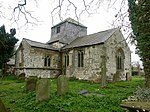Marshchapel

Marshchapel is a coastal village and civil parish in the East Lindsey district of Lincolnshire, England. It is approximately 11 miles (18 km) south-east from Grimsby and 13 miles (21 km) north-east from Louth. It includes the hamlets of West End and Eskham.Marshchapel has a village store cum post office, a primary school, and no public houses that are currently open, The church, dedicated to St Mary is a Grade I listed building dating from the 15th century with a chancel dating from 1848. St Mary's is often referred to as the "Cathedral of the Marshes". In the churchyard is a cross dating from the 14th century which was originally sited at the crossroads near West End. It is both Grade II listed and a scheduled monument.Marshchapel Primary School was originally built as a National School and was rebuilt in 1872, and has been known by its current name since September 1999.Marshchapel was the site of Anglo-Saxon salt-working.
Excerpt from the Wikipedia article Marshchapel (License: CC BY-SA 3.0, Authors, Images).Marshchapel
Sea Dykeway, East Lindsey Marshchapel
Geographical coordinates (GPS) Address Nearby Places Show on map
Geographical coordinates (GPS)
| Latitude | Longitude |
|---|---|
| N 53.473479 ° | E 0.045934 ° |
Address
Sea Dykeway
Sea Dykeway
DN36 5SX East Lindsey, Marshchapel
England, United Kingdom
Open on Google Maps








